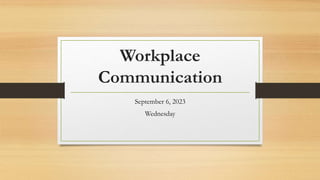
Workplace Communication.pptx
- 2. Workplace Communication •Effective workplace communication is essential for the success of any organization. It ensures that employees can collaborate efficiently, share information, and understand their roles and responsibilities.
- 3. Key aspects of workplace communication • Clear and Open Communication: Encourage open and transparent communication at all levels of the organization. • Active Listening: Listening is a crucial part of communication. Encourage employees to actively listen to their colleagues, superiors, and subordinates.
- 4. Key aspects of workplace communication • Use Multiple Communication Channels: Different messages may require different communication channels. Use face-to-face meetings, emails, phone calls, instant messaging, and collaboration tools like Slack or Microsoft Teams appropriately. • Written Communication Skills: Ensure that employees have strong written communication skills. This includes proper grammar, punctuation, and formatting in emails, reports, and other written materials.
- 5. Key aspects of workplace communication • Non-Verbal Communication: Non-verbal cues, such as body language and facial expressions, also play a significant role in communication. Be aware of how you and others convey messages non-verbally. • Feedback and Recognition: Regularly provide constructive feedback to employees on their performance. Recognize and reward achievements and contributions to boost morale and motivation.
- 6. Key aspects of workplace communication • Clarity and Conciseness: Keep your messages clear and concise. Avoid unnecessary jargon or overly technical language that may confuse your audience. • Cultural Sensitivity: In diverse workplaces, be mindful of cultural differences that can affect communication styles and preferences. Respect and adapt to these differences when necessary.
- 7. FORMAL LANGUAGE •Formal language refers to a type of language that is characterized by its adherence to established rules, structure, and conventions.
- 8. Key characteristics of formal language include: • Grammar and Syntax: Formal language adheres closely to the rules of grammar and syntax. It typically avoids sentence fragments, slang, contractions, and colloquialisms. • Vocabulary: Formal language uses a more extensive and sophisticated vocabulary compared to informal language. It avoids slang terms and instead employs words and phrases with specific, precise meanings.
- 9. Key characteristics of formal language include: •Tone: The tone of formal language is typically serious, professional, and respectful. It avoids humor, sarcasm, or overly emotional expressions that might be found in informal language. •Structure: Formal language often follows a structured format, especially in written documents.
- 10. Key characteristics of formal language include: • Third-Person Perspective: In many cases, formal language uses the third-person perspective (he, she, it) rather than the first person (I, we) or the second person (you). • Avoidance of Informal Pronouns: Formal language avoids the use of informal pronouns like "you" (singular) and "you all" (plural). Instead, it may use titles, honorifics, or more impersonal language.
- 11. Key characteristics of formal language include: • Proper Punctuation: Formal language places emphasis on proper punctuation, including the use of semicolons, colons, and dashes, where appropriate. • Precision: Formal language strives for precision in conveying information. It avoids vague or ambiguous terms and instead uses well- defined terminology. • Objective Language: Formal language tends to be objective and impartial, avoiding emotional language or biased expressions.
- 12. CASUAL LANGUAGE •also known as informal language, is a style of communication characterized by its relaxed, everyday, and conversational tone. It is the opposite of formal language, which adheres to established rules and conventions.
- 13. Characteristics: •Slang and Colloquialisms: Casual language often includes slang terms and colloquial expressions that may not be found in formal language.
- 14. Characteristics: • Contractions: Contractions, which involve combining two words into one (e.g., "don't" for "do not," "can't" for "cannot"), are common in casual language. In formal language, contractions are often avoided. • First-Person and Second-Person Pronouns: Casual language frequently employs first-person pronouns (I, we) and second- person pronouns (you) to engage the listener or reader directly.
- 15. Characteristics: • Sentence Fragments: Casual language may use sentence fragments, incomplete sentences, or ellipsis to mimic the flow of informal conversation. • Informal Tone: The tone of casual language is often relaxed, friendly, and conversational. It may include humor, sarcasm, or emotional expressions that are less common in formal communication.
- 16. Characteristics: • Everyday Vocabulary: Casual language relies on everyday vocabulary and may use common words and phrases rather than more complex or technical terminology. • Flexibility: Casual language allows for a more flexible approach to grammar and syntax. It may prioritize clarity and ease of communication over strict adherence to grammatical rules.
- 17. Characteristics: • Cultural References: It may include cultural references, idioms, or pop culture references that are easily understood within a specific social group or generation. • Personal Pronouns: In casual language, personal pronouns like "he," "she," and "it" are used naturally, whereas formal language may opt for more impersonal language or titles.